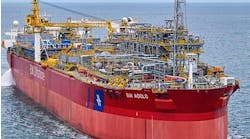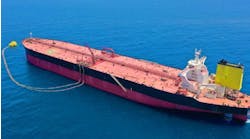Leonard LeBlanc
Houston
A Petrobras study has shown improved net present values on production and recovery on the deepwater Marlim Field when using subsea separation (SSS), subsea multiphase flow pumping, or eletrical submersible pumps in subsea wells (ESPS).
Like other rig upgrades taking place world-wide,Diamond Offshore's Ocean Quest semisubmersible will be boosted to 5,000 tons deckload with a 3,500 ft water depth capability by adding hull buoyancy (blue and green). Other additions include a self-contained mooring system, top drive, larger BOP stacks, and larger mud handling capacity. Conversion will be complete at the end of this year.
Silicate, cesium formate drilling fluids find performance success
Two recent developments in drilling fluids chemistry show promise in dealing with specific and general downhole conditions:
- Cesium formate: In early drilling tests conducted at the end of 1995, low-solids cesium formate based drilling fluids provided penetration rate gains up to 30% over conventional solids-weighted muds. The tests were conducted on six samples with a tricone bit and a mud density of 18.7 ppg. Cabot Corporation developed the fluid with the assistance of Baker Hughes Inteq.
- Silicates: Silicate water base drilling fluids, which have been around for a while, are gaining popularity in the North Sea for use in drilling chalk, soft hydratable clays, and microfractured shales. Silicate fluids cost 20-30% more than base muds, but are much less expensive than polygylcols, frequently used for stabilization.
Silicates inhibit the movement of water and chloride ions in shales and other formation materials by forming precipitates.
Liner, three packers set on same trip
BP, Nodeco, and CTC have successfully set a liner hanger in a horizontal well and cement-inflated three external casing packers, all on the same trip. The site of the operation was BP's Wytch Farm M4 well. The seven-in. liner was run in 1,682 ft of open hole. BP was prepared to rotate the liner during running because of expected differential sticking, but did not experience problems. Also, the inflation tool was run with the liner, reducing the risk of damage to the 9-5/8-in. casing seals.
Tankers win out over pipelines
Brazil's Petrobras has canceled 760 km of proposed offshore and onshore pipelines in favor of tankering production from the two floating production units on the Marlim and Albacora Fields. Studies indicate that a proposed pipeline scheme would have cost Petrobras $1.13 billion through the year 2001, while a tanker scheme will cost only $534 million.
Brazil has relatively mild offshore weather and the proposed FPSO units could offload directly to shuttle tankers with 99% operating efficiency. Making the process possible are the conversion of supertankers with large storage capacities to FPSO units and the use of at least four supertankers for shuttle operations. A total of six vessels will engage in shuttle operations with a complete cycle time of six days for each vessel.
Merlin connector set for deepwater
The Merlin pipe connection, which features box and pin systems with parallel ribs instead of screw threads, is finding a use in offshore pipelines. The system was successfully used in tendon connections for the Auger and Mars tension-leg platforms. As a result, the technology was employed for pipeline connections on a two km pipeline laid between the Harding platform and a tanker loading terminal.
Use of the connectors allows the welding assembly of long pipeline strings onshore and tow-out. At the site, the pipe sections are lowered to the seabed and maneuvered into position with a 30-ton remotely operated system, which also doubles as a connection unit. For the Harding pipelay job last fall, the pipe sections were 75 meters long and diver support was used. Developers are planning on much longer sections within tubing yield point in the future for deepwater.
The Merlin connection features a series of parallel ribs on the OD of the pin, which are mated with similar ribs on the ID of the box. Upon insertion of the pin and encirclement with a clamp, hydraulic fluid is injected between the corresponding ribs, in effect compressing the pin and expanding the box. The ribs are separated in the process and a 400-ton force is placed axially on the two pipes until the pin and box nibs engage fully. Upon release of hydraulic pressure, the pin and box ribs form metal-to-metal seals. The entire connection process is reversible.
Platform removal system developed
Two Statoil engineers have developed a dedicated system for removal of steel platforms without use of a heavy-lift crane. The deck/topside and jacket of each platform are removed intact and floated to shore, where they can be disassembled at costs of less than 15% of that experienced offshore. Brian Stead and Ove Gudmestad have developed patentable lifting solutions to achieve the removals:
- U-shaped vessel: A wide vessel with a removable inner hull slides under and around the jacket legs and commences to ballast up under the deck. The jacket legs are cut under the deck and the load transferred to the vessel. Ballast tanks are used to correct for displaced center of gravity. The vessel then takes the deck to shore for disassembly.
- Jacket lifter: After the shallow cross members are cut, a large supply vessel equipped with deck winches slips between the platform legs. The jacket piles are cut at the seabed and the jacket is lifted beneath the vessel by the winches and towed to shore or deepwater. This system depends upon sufficient water depth to move the suspended jacket.
- Shearlegs plus submersible: For smaller steel platforms, two small pieces of equipment - a floating shearlegs crane and a submersible barge with steel shafts installed on deck - can be assembled offshore for lifting out topsides and jackets economically. The submersible is ballasted down until the shearlegs can be floated on and attached, thus increasing the lift capacity and acting like a semisubmersible hull.
Did you know...
The torque rating loss when shifting from conventional 4-1/2-in. E-grade drillpipe to slimhole 2-7/8-in. pipe is a significant 74% (30,810 ft-lb to 8,080 ft-lb)
Source:Weiss, M., The Brief, December, 1995.
At low temperatures, the tensile strength of aluminum increases. Unlike steel, aluminum does not become brittle at low temperatures. On the other hand, aluminum's tensile strength at temperatures above 100C drops quickly. Aluminum melts at 600 C, while steel melts at 1,500C.
Source:Esab Welding Review, No. 3, 1995.
Copyright 1996 Offshore. All Rights Reserved.


